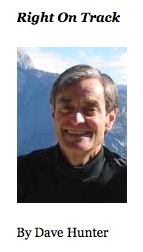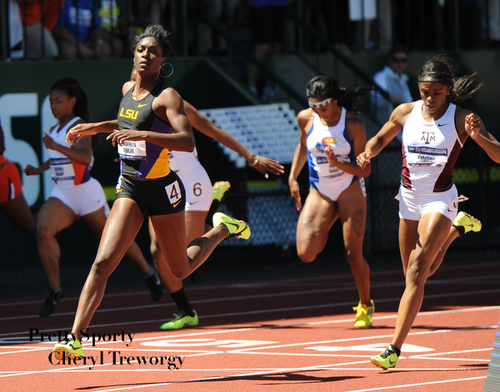2013 NCAA Div I Outdoor Track & Field Championships
RelatedPosts
Day Two: The Expected And The Unexpected
June 6, 2013
Eugene, Oregon
The pre-meet form sheet wasn’t always that helpful as Day Two of the 2013 NCAA outdoor track & field championships sprinkled in more than a few surprises among more orthodox results – many of which were truly stunning.
Another beautiful day began with the second and final day of the decathlon. Conventional wisdom forecasted a tight three-way struggle among first-day leader Jeremy Taiwo of Washington, Duke’s Curtis Beach, and Texas’ Johannes Hock. It didn’t play out quite that way.
Taiwo – who clung to a slim 6 point lead over Beach after Day One – pushed the margin out to 54 points after posting a sparkling 14.16 in the 110H. But the 7th event – the discus – gave Hock the opening he needed. A big throws performer, the German Longhorn – a mountain of  a man whose Tom Pappas-like physique makes him look like a Teutonic god – knew what to do. Spinning the platter 50.61m [166′], Hock earned 883 points to take the lead when the Husky senior – an unabashedly weak discus performer – could only manage 34.90m [114’6″].
a man whose Tom Pappas-like physique makes him look like a Teutonic god – knew what to do. Spinning the platter 50.61m [166′], Hock earned 883 points to take the lead when the Husky senior – an unabashedly weak discus performer – could only manage 34.90m [114’6″].
Meanwhile, the hoped-for strong second day was not to be for Beach. A decent hurdle run [14.54] was followed by a horrid discus mark [37.21m / 122’1″] and a woefully sub-par vault [15’1″]. And when Beach’s feeble javelin effort produced only a sad 116′ mark, everyone knew something was very wrong. [Beach’s father later confided that the Duke star is still plagued by a lingering elbow injury from the ’12 Trials and that surgery may be necessary…]
As the decathletes prepared to end their day with the final 1500, Hock had a sizeable – but not insurmountable – 171 point lead over Taiwo. A scurried review of their 1500 performances revealed that if Taiwo – with superior middle distance skills – and Hock ran to their lifetime best potential, the outcome might be a flat-out tie. As the 1500 unfolded – and Beach vented his frustration by pounding out an impressive 4:03.64 win – all eyes were on the two leaders. The German – who knew he had to stay within 28 seconds of Taiwo – was ready for the final battle. “I knew it could be a tie with our PR’s. It always comes down to the 1500,” Hock explained. The Texas multi-performer was able to get it done as his 1500 mark of 4:37.9 kept him close enough to Taiwo [4:16.34] to preserve the victory and give him an “A” standard mark for the upcoming World Championships. “I have run a lot of workouts and I knew that I was ready,” offered Hock. “I just gave it my all and I’m really happy that it worked out that way.” Did he keep his eye on the Husky up ahead? “I had no clue where he was.”
The second place Taiwo was a post-event realist. “There were a lot of ups and downs,” he reflected. “I’m just happy I got the ‘A’ standard [8200 points for the World Championships]. I wish I could have finished in first place, but he [Hock] had a great two days. He was PRing all over the place.”
The sole track final on Day Two was the men’s 10,000. Like the women’s 10K where ultimate victor Betsy Saina was an intimidating competitor, the mere presence of Arizona junior Lawi Lalang on the starting line commanded respect and forced strategy changes amongst the field. Under sunny skies and warm 82 degree temperatures, the field of 24 began cautiously at 5:00/mile pace. After 6 easy laps, an impatient Lalang went to the lead – not to throw down a move, but merely to control the race from the front. What followed was a subtle turning of the screw as the Wildcat slowly lifted the pace. On lap 12, Lalang began to mete out the pain – departing from the pre-exist lap speed in the low 70 second range to toss in an occasional circuit in the mid-60’s. As expected, it was a strategy that thinned the herd. Shortly after halfway – on the heels of a Lalang-initiated surge – a tidy pack of Lalang, Oklahoma State’s Girma Mecheso, and BYU’s Jared Ward broke away from the field – soon to be joined by UNC-Greensboro junior Paul Katam.
With little more than a mile remaining, Lalang’s benevolence came to an end and the real racing commenced. The Arizona star broke away with a sequence of laps in the 64-65 second range which earned him a 35 meter lead as the penultimate lap commenced. For all practical purposes, the race for the 10,000 title was over.
But a curious “race within the race” had been building. Over the final two circuits, Katam – the last of Lalang’s spurt victims – was caught by Texas’ Craig Lutz, Florida State’s Michael Fout, and Princeton’s Michael Franklin. The crowd roared as this quartet weaved through lapped runners, straining for an advantage. As Lalang glided over the finish line in 29:29.65, 80 meters back up the track places 2-5 were still up for grabs as the trailing foursome rounded the Bowerman curve. Katam’s sprint gave him a slight advantage which he held to the line – while just meters behind followed Lutz, Fout, and Franklin to finish 3-4-5 – all four within 1.5 seconds. In the mixed zone, Lalang revealed his pre-race strategy. “I wanted to take it as easy as possible because I know the 5K on Saturday will be a really hard one,” he offered. Questioned about any concerns he might have for Oregon’s recent heat surge, Lalang quipped, “It’s warm in Arizona, too.” Asked about his outlook for the 5000, Lalang smiled and said, “Whatever these guys are ready for, I’m ready for.”
The nation of hammer junkies – and they were out in force – were treated to a great competition in the men’s hammer throw. Virginia Tech’s Tomas Kruzliak’s second round heave of 69.26m [227’2¾”] held up for the win. Florida’s Jeremy Postin and Oregon frosh Greg Skipper finished third and fourth to garner important points in the chase for the team title.
The swirling wind played havoc with virtually every competitor in the men’s long jump as 12 of the 18 first round jumps were fouls. But one athlete who mastered the wind was LSU senior and Jamaican Damar Forbes. On his second jump, Forbes uncorked a beauty – an all-conditions collegiate-leading leap of 27’4¾” [8.35m] – which easily stood up for the victory. “I figured out during the warm-up that the wind was blowing much harder and I needed to go a lot further back to stay on the board. I thought that even if I jumped from behind the board, I’m still going to get into the finals.” He was right. “When I landed [on that second jump], I knew it was far because I heard the crowd.” And with a smile, the champion added, “I was in the air a long time. It felt good.”
The 200 semis produced some form chart deviations. On the men’s side, Texas A&M lost Prezel Harvey and Michael Bryan while Ameer Webb moved on – winning his semi in 20.05. Look for Webb to challenge USC’s Bryshon Nellum [19.99] and collegiate leader Anaso Jobodwana [20.02] for the furlong crown.
In the women’s 200, the host Ducks sustained a huge potential point loss when sprint star English Gardner – obviously laboring – struggled home 7th in her semi-final. Acknowledging some right ankle swelling and pain, Gardner remains day-to-day as the Lady Ducks continue their quest for an unprecedented cross country-indoor-outdoor “Triple Crown.” Kimberlyn Duncan – who looked fabulous gliding 22.15 in her semi – is the lady to beat. But the UCF duo of Aurieyall Scott and Octavius Freeman are poised to pull the upset should Duncan falter
.
The 4 x 400 semis – always a crowd favorite – offered sterling times and tight competition. On the men’s side, the quality of performance required to advance was stunning. If you couldn’t crank out a time in the low 3:05 range, you received a lovely parting gift. Thanks for playing. The powerhouses in the team title chase – Texas A&M, Florida, and Oregon – all made what should be a wild and wooly final. But it will take a Herculean effort for a challenging quartet to finish ahead of the Aggies – who dominated their semi-final in 3:02.38 with Deon Lendore not yet showing his full game.
In the women’s 4 x 400, the Oregon women showed why they should be considered the final favorite. Prandini, Okodogbe, Roesler, and Francis rang up a collegiate leading 3:28.15 and sent their competition a little statement. Look for Texas and time qualifiers Florida and Illinois – featuring the Spencer sisters – to push the Lady Ducks.
Long-awaited finals will dominate the Day Three schedule – as strong teams and outstanding individuals will finally start pulling down the hardware and ringing up those all-important team points.
~Dave Hunter
Author

Larry Eder has had a 52-year involvement in the sport of athletics. Larry has experienced the sport as an athlete, coach, magazine publisher, and now, journalist and blogger. His first article, on Don Bowden, America's first sub-4 minute miler, was published in RW in 1983. Larry has published several magazines on athletics, from American Athletics to the U.S. version of Spikes magazine. He currently manages the content and marketing development of the RunningNetwork, The Shoe Addicts, and RunBlogRun. Of RunBlogRun, his daily pilgrimage with the sport, Larry says: "I have to admit, I love traveling to far away meets, writing about the sport I love, and the athletes I respect, for my readers at runblogrun.com, the most of anything I have ever done, except, maybe running itself." Also does some updates for BBC Sports at key events, which he truly enjoys. Theme song: Greg Allman, " I'm no Angel."
View all posts





















